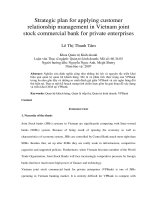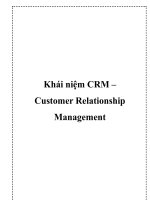Customer Relationship Management Concepts And Technologies
Bạn đang xem bản rút gọn của tài liệu. Xem và tải ngay bản đầy đủ của tài liệu tại đây (1.42 MB, 59 trang )
CUSTOMER RELATIONSHIP MANAGEMENT
CONCEPTS AND TECHNOLOGIES
Managing the customer lifecycle –
customer retention and development
Three stages of the customer lifecycle
1. Customer acquisition
2. Customer retention
aims to keep a high proportion of current customers by
reducing customer defections
3. Customer development
aims to increase the value of those retained customers to
the company
Generic goals of customer retention and development
Customer retention: to keep a high proportion of
valuable customers by reducing customer defections
(churn).
Customer development: to increase the value of
those retained customers to the company.
Simple customer retention definition
Customer retention is the number of customers doing
business with a firm at the end of a financial year
expressed as percentage of those who were active
customers at the beginning of the year.
The appropriate time frame
Depends on repurchase cycle found in the industry
● Insurance policies are renewed annually.
● If the normal replacement cycle is four years, then retention
rate is more meaningful if it is measured over four years
instead of 12 months.
Can you tell if a customer has defected?
May not be able to measure retention and defection if
you have
● Product-based views of customers
● Channel-based views of customers
● Separate customer records in sales, marketing and service
Three measures of customer retention
Raw customer retention rate
● the number of customers doing business with a firm at the end of a
trading period expressed as a percentage of those who were active
customers at the beginning of the period.
Sales-adjusted retention rate
● the value of sales achieved from the retained customers expressed
as a percentage of the sales achieved from all customers who were
active at the beginning of the period.
Profit-adjusted retention rate
● the profit earned from the retained customers expressed as a
percentage of the profit earned from all customers who were active
at the beginning of the period.
Retention issues
Retention measures should be made with an understanding of
customer profitability issues
The fundamental purpose of focusing CRM efforts on customer
retention is to ensure that the company maintains relationships
with strategically significant customers
It may not be beneficial to maintain relationships with all
customers. Some are
● too costly to serve
● strategic switchers constantly in search of a better deal
● not strategically significant in roles such as benchmark, door
opener, inspiration or technology partner
Customer retention vs. value retention
Companies should focus on retaining customers that
contribute value
Sometimes this will mean that the focus is not on
retention of customers, per se, but on retention of
share of wallet
● In the banking industry, for example, it may be more
important for companies to focus on managing the overall
downward migration of customer spending than customer
retention. Many customers simply change their buying
behaviour rather than defect.
The economic argument for customer retention
Purchases grow as tenure grows
Customer management costs fall over time
Customer referrals grow
Premium prices
● Customers who are satisfied in their relationship may reward
their suppliers by paying higher prices
Which customers to retain?
Strategically significant customers
●
●
●
●
●
High lifetime value customers
High volume customers
Benchmarks
Inspirations
Door openers
But … these may also be attractive to your
competitors
Commitment and retention
The level of commitment between your customer and
you will figure in the decision about which customers
to retain
● If the customer is highly committed, i.e. impervious to the
appeals of competitors, you do not need to invest so much in
retention.
● If strategically significant customers are not committed to
you, you may want to invest considerable sums in their
retention.
Why focus on newly acquired customers?
New customers may have greater future lifetime
value potential than longer tenure customers
● evidence suggests that retention rates rise over time, so if
defections can be prevented in the early stages of a
relationship, there will be a pay-off in future revenue
streams.
Two basic strategies for customer retention
Negative and positive customer retention strategies
Create exit barriers
Enforce the contract
Extract switching
penalties
Delight customers
Create customer-perceived
added value
Create social and structural
bonds
Create customer
engagement
DRIVER TO INCREASE CUSTOMER VALUE
Increasing the level of expenditure
Increasing cross-buying
Encourage customers to diversify their purchases
Encourage the customer to reduce average
repurchase
times
Encourage the customer to reduce the number of
refurbishments/returns required
Encourage the customer to reduce the frequency of
contacts or push them towards communication
channels at a lower cost of ownership.
CLASSYFY CRM TOOLS
Tools that try to work on “time” of purchase
Tools that try to work on “value” of purchase
Tools that try to work on “strength” of relation
What is customer delight?
Customer delight = P > E
where
P = Perception
E = Expectation
Bridging the gaps: importance against performance
Clean toilets
Importance
5.5
OFI
2.5 Performance
Importance
6.5
Food quality
4.5
Performance
OFI
Numbers are scores
on a 7-point scale
OFI
= opportunity for improvement
Customer delight through product quality
Simple ways to delight customers
provide information about the customer’s served
market
● A packaging company could alert a fast-moving consumer
goods manufacturer customer to competitive initiatives in the
market.
volunteer to collect and replace a faulty product from
a customer rather than issuing a credit note
offer better, lower cost solutions to the customer,
even though that might reduce margin
Three ways to create customer-perceived added
value
1. loyalty schemes
2. customer communities
3. sales promotions
Loyalty programme definition
A loyalty scheme is a customer management
programme that offers delayed or immediate
incremental rewards to customers for their cumulative
patronage.
Reward programmes
Co-op dividend > Green Shield Stamps
> American Airlines’ AAdvantage Card > Nectar
Card-based schemes have changed over time
●
●
●
●
●
No identification – member’s name
Magnetic strip – chip-embedded
Solus – networked
Company-operated – third-party operated
Trivial reward – major reward (5%)
Nectar loyalty programme









